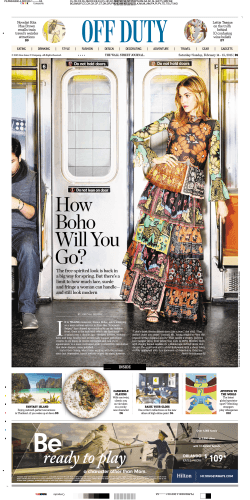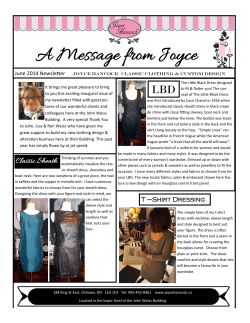
White Paper 23-â09 Analysis of #TheDress Summary Introduction
An Analysis of #TheDress in 23andMe Customers Authors: Fah Sathirapongsasuti Catherine Wilson Jesse Engelberg Robert Bell David Hinds Cory McLean Created: March 23, 2015 White Paper 23-‐09 Analysis of #TheDress Last Edited: March 26, 2015 Summary This white paper is to supplement the analysis results reported in the blog post. We describe the data collection process and analysis methods and briefly discuss our findings. Introduction In late February 2015, an online debate broke out over the perceived color of “The Dress.” In response to the popular interest and requests from the community, 23andMe invited our customers to help contribute to what could be a one of the largest studies on the debate. Through various media, experts offered explanations for this phenomenon, but without data, these remain speculative. What makes “The Dress” an interesting trait, or “phenotype,” to us is its uniqueness. Visual phenomena about which people’s opinions are so divided and persistent as they are about the colors in “The Dress” are extremely rare. For similar traits such as color blindness, March 25, 2014 White Paper 23 -‐ 09 An Analysis of #TheDress in 23andMe Customers genetic component can be quite strong (odds ratio > 2) and can be detected in a moderate size study (~10,000 samples). As a customer-‐driven research organization, 23andMe has a unique opportunity to invite customers to help understand these phenomena. We set out to test the following hypotheses: 1. Aging. The cones and rods in the retina decline in sensitivity and the cornea yellows as we age (Telegraph). If this is true, we should see an effect based on age. 2. The rod and cone cells function differently (John Hopkins, CNN). If this is true, we might see association with genes involved in the development and regulation of these retinal cells. 3. Color consistency. Our brain reads different contextual cues to decide the colors we perceive (Huffington Post, NYT). If this is true, we might see association with certain life experience or professions that may have primed the brain to recognize different visual cues. We received over 25,000 responses, enough to detect a large genetic effect should one exist. As reported in the blog post, genome-‐wide association study (GWAS) detected no genetic association that had a large effect. Instead, we found age, sex, and age-‐by-‐ sex interaction to be significantly associated with the color perception of “The Dress.” Through a phenome-‐wide association study (PheWAS), we also identified other, unexpected traits such as type of childhood residence, shift work, and liposuction, which contributed to color perception. Data Collection Between March 13 and March 15, 2015, an IRB-‐approved email was sent to a subset of 23andMe customers who had previously consented to participate in research. Two questions related to “The Dress” were asked in form of short questions. March 25, 2014 White Paper 23 -‐ 09 An Analysis of #TheDress in 23andMe Customers Figure 1 shows the questions. A. B. Figure 1 Quick question for (A) current color perception and (B) initial color perception. Images were screen-‐captured from 23andMe.com on March 23, 2015. March 25, 2014 White Paper 23 -‐ 09 An Analysis of #TheDress in 23andMe Customers Overall Statistics As shown in Figure 1, the majority of responses are “white and gold” or “blue and black.” However, a substantial percentage (11%) of customers chose “other,” which represents colors such as blue and gold. The respondents represent a reasonable sampling of the 23andMe customer base in terms of age (mean: 50.7, SD: 16.8), while women are slightly overrepresented (51.5%). Table 1. Percent of responses cross-‐tabulated by the change from initial to current perception. Current Blue/Black White/Gold Switching Blue/Black 84% 13% 4% White/Gold 11% 84% 5% Switching 32% 43% 24% Not seen 41% 53% 6% Initial Genome-‐Wide Association Studies (GWAS) We tested each of the genotyped single nucleotide polymorphisms (SNPs) in a logistic model with white/gold as cases and blue/black as controls, adjusting for age, sex, and population substructure (using the first five principal components of genetic variation), and restricting to respondents of European descent. Three phenotypic concepts were used as outcomes: current color perception, initial color perception, and consistent perception. Current and initial color perceptions are the responses from the two short questions binarized to the two most common choices (white/gold vs blue/black). “Consistent” perception is based on the subset of customers who selected the same answers to both binarized questions. About 84% of the responses were consistent (Table 1). None of the three GWASs yielded genetic association that meet the 5x10-‐8 genome-‐ wide significance level. The strongest hit came from the analysis of initial color perception where a SNP (rs4768609) in the ANO6 gene achieved an odds ratio (OR) of 1.16 (p-‐value=2.3x10-‐6). The analysis of consistent color perception is largely underpowered and yielded no appreciable trend. A power calculation based on the observed sample size (5,977 cases; 3,323 controls) suggests that the analysis is well-‐powered to detect large effect size (OR > 2) but does March 25, 2014 White Paper 23 -‐ 09 An Analysis of #TheDress in 23andMe Customers not have sufficient power to detect smaller effects (OR < 1.2). Thus, we concluded that a large genetic effect of “The Dress” is likely absent. However, smaller effects such as ones on ANO6 gene may achieve significance with a larger sample size (N > 50,000). Figure 2 Manhattan plot from GWAS of initial color perception. Phenome-‐Wide Association Study To assess the effect of other phenotypes on the color perception of “The Dress,” we performed association tests across 2,622 phenotypes that have sufficient overlap with “The Dress” phenotype. We used a logistic regression with consistent color perception as outcome, adjusting for sex, age, and population substructure. Since the effect of age is strong and likely non-‐linear, we adjusted age up to a third degree (age + age2 + age3). After Benjamini-‐Hochberg adjustment for multiple-‐hypothesis testing, we considered phenotypes at false discovery rate (FDR) lower than 0.25. Among them are liposuction (OR=2.83, p=6.2x10-‐4, FDR=0.18), shift worker (OR=1.95, p=5.7x10-‐4, FDR=0.18), and type of childhood residence (OR=0.94, p=6.3x10-‐4, FDR=0.22). Other phenotypes meeting the cutoff are likely capturing the residual effect of age, for example, number of children or having had a coronary bypass surgery. Conclusion Thanks to our customers, 23andMe was able to collect over 25,000 responses to our survey questions about “The Dress.” As reported, we did not find any genetic determinant that explains a significant fraction of color perception differences. Instead, we found that all of the hypothesized mechanisms likely play roles in shaping our perception of “The Dress” and the visual world in general. The effect of age is strong and may be explained, at least in part, by the physiology of aging. With age, the March 25, 2014 White Paper 23 -‐ 09 An Analysis of #TheDress in 23andMe Customers retina shows decreased contrast sensitivity, increased dark adaptation threshold, decreased number of photoreceptors, and increased lipofuscin content (Salvi, Akhtar, and Currie 2006). We did not find significant genetic association in opsin genes (OPN1LW, OPN1MW, and OPN1SW), which encode pigments in cone cells and are associated with colorblindness. However, we observed a nonsignificant association with a mutation in the intron of ANO6 gene. ANO6 is interesting in that it belongs to the same family as ANO2, which regulates light perception amplification in the retina (Stohr et al. 2009). Finally, environment appears to play a part. The associations with shift work and type of childhood residence suggest that exposure to sunlight and artificial light sources might shape our color perception. Overexposure to both sunlight and fluorescent light can damage the eyes (Walls, Walls, and Benke 2011) and such perturbation can have lasting effects on neural sensitivity to color (Neitz et al. 2004). This observation does not exclude the possibility that the environment in which one grew up or works may cause the brain to perceive color slightly differently. Although we identified a few predictors of one’s color perception of “The Dress,” they account for only a small fraction of the total variability (linear model R2 ~5%). As we concluded in the blog post, this study demonstrates the complexity of our visual perception and the many factors that influence its functions. For us at 23andMe, this whole exercise is an experiment of its own. This is one of the fastest end-‐to-‐end projects we have done in recent years (two weeks from idea to results), and it was possible not just because we have a robust data collection and analysis pipeline but more importantly because we have engaged customers such as yourself. For this, we thank you. Acknowledgments This study would not have been possible without efforts and support of 23andMe researchers, engineers, and staff. In particular we thank Justin Ho, Jun Boo, and Christian Peccei for designing and executing the email communication; Arnab Chowdry and Chao Tian for analysis support; Matthew Strand, Michael Pan, and Joshua Bloom for engineering support; Scott Hadly for writing the blog post; and Joyce Tung and Anne Wojcicki for their leadership. Finally, we thank you, our customers, for being our partners in research. March 25, 2014 White Paper 23 -‐ 09
© Copyright 2025











